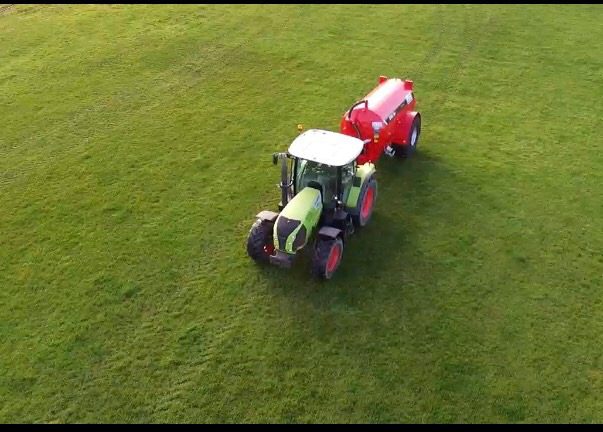New regulations come into force on 1 January 2022 with some phased in over five years. Scottish Government has announced amendments to the Water Environment (Controlled Activities) (Scotland) Regulations 2011 following its 12-week consultation earlier this year. These include improving controls on the storage of slurry and digestate to reduce leakage, and more targeted spreading to maximise the nutrient benefit and reduce emissions.
Key elements of the regulatory changes include the phasing out of broadcast spreading of slurries by splash plates and the introduction of low-emission, precision spreading equipment. In a lobbying success for NFUS, slurry stores built prior to 1991, providing they are fit for purpose can be retained. However, all farms must have adequate slurry storage – 22 weeks for those keeping cattle and 26 weeks for pigs. If storage improvements are needed, the changes will be phased in with some farms having five years to comply. If a pre-1991 store is to be ‘reconstructed or enlarged’ to meet storage requirements then it will no longer be exempt and will then have to comply with the British Standards.
NFU Scotland’s priority will be ensuring all farmers and crofters are aware of the rule changes and ensuring that any significant investment needed on farms to comply will be adequately supported by Scottish Government. It will also work with regulatory body SEPA to explore pragmatic options for compliance that take individual circumstances into consideration, encouraging compliance but also ensuring farmers are not penalised for things out with their control.
Environmental Resources Policy Manager Sarah Cowie said: “In what has been a nationwide consultation exercise for NFUS, we welcome that Scottish Government has recognised and revised the proposals that were of highest concern to our farmers and crofters.
“In the months since the consultation closed, we have been involved in constructive conversations with civil servants and SEPA with the aim of addressing these. Without the very active engagement of our members, this would have undoubtedly resulted in more costs being imposed on the industry.
“As a result, the proposals have been revised to make it easier for farmers to comply, while at the same time the primary objectives of reducing the risk of point of source pollution, diffuse pollution and minimising emissions, which NFU Scotland supports, can still be achieved. We will study the final version of the regulations that will come into force at the start of the 2022 and make sure our members have as much information as possible.
“When first published, the proposals drew a great deal of consternation and worry that significant capital investment for facilities and upgrades would be required to comply. A clear omission from the Scottish Government announcement today is what funding will be available to assist the industry to make necessary changes.
“The only available Scottish Government support for slurry storage in 2021 was through a very limited Agri-Environment and Climate Scheme (AECS). While AECS rounds for 2022-24 have been confirmed, there are no details on whether this is an option for slurry storage and spreading investment during the transitional period.
“NFUS is clear that where significant capital investment is required by farm businesses, adequate, non-competitive funding should be provided to allow them to adapt and invest in upgrades and equipment in order to comply with the regulations.”
Reducing agricultural emissions
Published: 12 Nov 2021 12:02
Part of:
Farming and rural, Environment and climate change
Improved controls on the storage and application of slurry and digestate.
Changes to the way that slurry and digestate is stored and spread on farms could lead to a reduction of up to 70% of the harmful ammonia that is released.
Amendments have been made to the Water Environment (Controlled Activities) (Scotland) Regulations 2011. These include improving controls on the storage of slurry and digestate to reduce leakage, and more targeted spreading to maximise the nutrient benefit and reduce emissions.
Agriculture is the largest contributor to ammonia emissions and a key element of the regulations is the phasing out of broadcast spreading of slurries by splash plates and the introduction of low-emission, precision spreading equipment.
The changes are being made following a 12 week public consultation and engagement with the agricultural sector and the National Farmers Union Scotland (NFUS). The changes will be phased in, with some farms having up to five years to comply.
Minister for Environment and Land Reform Màiri McAllan said:
“While slurry and digestate are important nutrients for use on our farms, they can also be damaging to our natural environment if not used properly, causing harmful emissions into our air and water.
“Agriculture accounts for around 90% of ammonia emissions. By using low emission, precision equipment, we can reduce the ammonia emissions by up to 70%, protecting our vital water environment and reducing the agricultural impact on climate change.
“This will also make an important contribution to the commitments on reducing air pollutant emissions from agricultural activity, which are set out in our new air quality strategy published earlier this year.
“We understand that farms will not be able to introduce these changes overnight. We have engaged with and listened to the concerns of farmers and where possible have made alterations that would allow us to meet the aims of the regulations while reducing the impact on businesses.
“We will continue to work with the NFUS and our farming communities to ensure a continued thriving agricultural sector, while meeting our obligations to achieve net zero.”
Background
The Water Environment (Controlled Activities)(Scotland) Amendment Regulations 2021 will come into force from 1 January 2022.
Key facts:
The total quantity of slurry produced in Scotland is estimated at 6.35 million tons (1.67 billion gallons) per annum.
A single 10 m3 tanker of slurry can have an equivalent fertiliser value of between £30 to £50. Better use of the nutrients in slurry/manure/digestate can reduce fertiliser bills.
Spreading slurry using a splash plate can lose around 30% of the available nitrogen as ammonia gas in just the first 3 hours.





